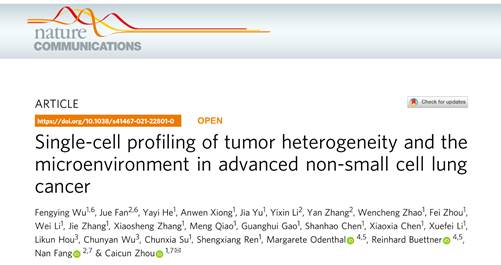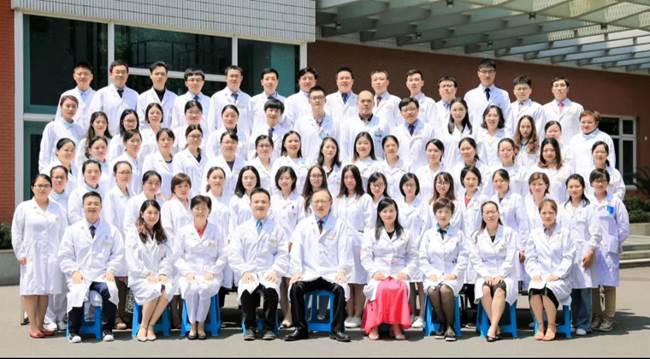On May 5, Prof. ZHOU Caicun’s team published a paper online titled “Single-Cell Profiling of Tumor Heterogeneity and Its Microenvironment in Advanced Non-small Cell Lung Cancer” on Nature Communications. In the study, the single-cell sequencing is employed to profile the non-small cell lung cancer (NSCLC) and define the characteristics of late-stage NSCLC patients in respect of the tumor heterogeneity, phenotypes and infiltration of stromal and immune cells, and interaction microenvironment. It also reveals a correlation of tumor heterogeneity with associated neutrophils, which might help to shed light on the function of neutrophils in NSCLC and their potential of prediction in immunotherapy.

The paper by Prof. ZHOU Caicun’s team published on Nature Communications
Lung cancer, the malignant tumor with the highest morbidity and mortality in China, is dreadfully harmful to human. Over the past two decades, the lung cancer treatment has developed by leaps and bounds, with targeted medicines and immunization medicines significantly extending the life of late-stage patients. However, there are some problems affecting the clinical treatment, such as tumor cell heterogeneity, tumor microenvironment composition heterogeneity, and interaction between tumor cells and immune and stromal cells. Solving the problems will help create new intervening strategies, further improve treatment effect and bring about new breakthroughs in clinical treatment.
According to Dr. WU Fengying, the first author, they have discovered that the lung squamous carcinoma has higher inter- and intra-tumor heterogeneity than lung adenocarcinoma, and that the major clones represent a lower percentage by using the single-cell sequencing to analyze the biopsy samples from 42 NSCLC late-stage lung cancer patients, scoring the tumor heterogeneity in respect of copy number alteration (CNA) and gene expression profiling (GEP), and examining three groups of patients - LUADm (lung adenocarcinoma with mutation), LUADn (lung adenocarcinoma without mutation) and LUSCn (lung squamous carcinoma without mutation),. However, the late-stage patients have a higher intra-tumor heterogeneity than the early-stage ones. The study reveals the extensive clonality of late-stage lung cancer and the relation between genotypes and phenotypes, suggesting a complexity beyond the existing NSCLC classification systems.
The tumor heterogeneity and complexity are not limited to the tumor cells, but also embodied in the phenotypes and distribution of immune and stromal cells. In the paper, the T/NK cells, B cells, Myeloid cells, neutrophils, fibroblasts and vascular cells are also characterized for subtypes. For example, in tumor-infiltrating CD8+ T cells, the exhausted T cells with upregulated immune checkpoints show higher infiltration than effector T cells; and the states of macrophages is more complicated than the traditional M1/M2 classification, and they promote tumor through the associated gene expressions such as chemokine, extracellular matrix proteins and interferon response. The infiltration features of different immune cell subtypes, genes with upregulated heterogeneity, and interaction between different subtypes are closely related to the tumor phenotypes and clinical prognosis. The specific CXCL9-expressing macrophage subtypes are enriched in patients with effective immunization treatment; and macrophages inhibit T cells through different immune checkpoints. All of the findings will contribute to the discovery of new therapeutic targets and prognosis biomarkers.
The study, of essential scientific values, provides the profiling of cells and microenvironment in the late-stage NSCLC, offering a strong basis for guiding the subsequent commercialization study and seeking new cell targets and molecule targets, says Prof. ZHOU Caicun, the corresponding author of the paper.

Prof. ZHOU Caicun’s team
https://news.tongji.edu.cn/info/1003/77546.htm